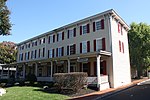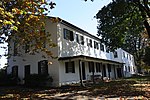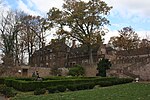David Leedom Farm

David Leedom Farm, also known as "Pleasant Retreat," is a historic home and farm located at Newtown Township, Bucks County, Pennsylvania. The house was built in four stages, with the oldest dated to the late 18th century and consisting of a one-story, one roof stone structure. A large, 2 1/2-story stone addition was built in the late-18th century. In 1802, a three-story, stone "mansion" section was added. A two-story, frame addition was built in the early 1800s. The house features a series of piazzas and the interior of the mansion section has a three-story staircase. Also on the property are a variety of contributing farm-related buildings. The house was featured in one of four Newtown farmscape paintings by noted artist Edward Hicks (1780-1849).It was added to the National Register of Historic Places in 1976.
Excerpt from the Wikipedia article David Leedom Farm (License: CC BY-SA 3.0, Authors, Images).David Leedom Farm
Leedom Place, Newtown Township
Geographical coordinates (GPS) Address Nearby Places Show on map
Geographical coordinates (GPS)
| Latitude | Longitude |
|---|---|
| N 40.221944444444 ° | E -74.956944444444 ° |
Address
Leedom Place
Leedom Place
19840 Newtown Township
Pennsylvania, United States
Open on Google Maps









